Mental Health for Communities: Culture, Environment, and Support
VerifiedAdded on 2021/04/24
|12
|3550
|26
Essay
AI Summary
This essay delves into the multifaceted nature of mental health within communities, emphasizing the significant roles of culture, environment, and support systems. It examines how individual mental well-being is influenced by various factors, including family dynamics, societal attitudes, and environmental stressors. The essay highlights the challenges faced by children from single-parent families and how they are often perceived and treated by society, which can significantly impact their mental health. It discusses the effects of underemployment, economic hardship, and the attitudes of society. The essay also explores the impact of environmental factors, such as workplace pressures, and the importance of a strong support system, including healthcare, family, and community involvement, in promoting mental wellness. The essay concludes by stressing the need for patience, understanding, and adaptive abilities in addressing mental health issues and fostering a more inclusive and supportive community environment.
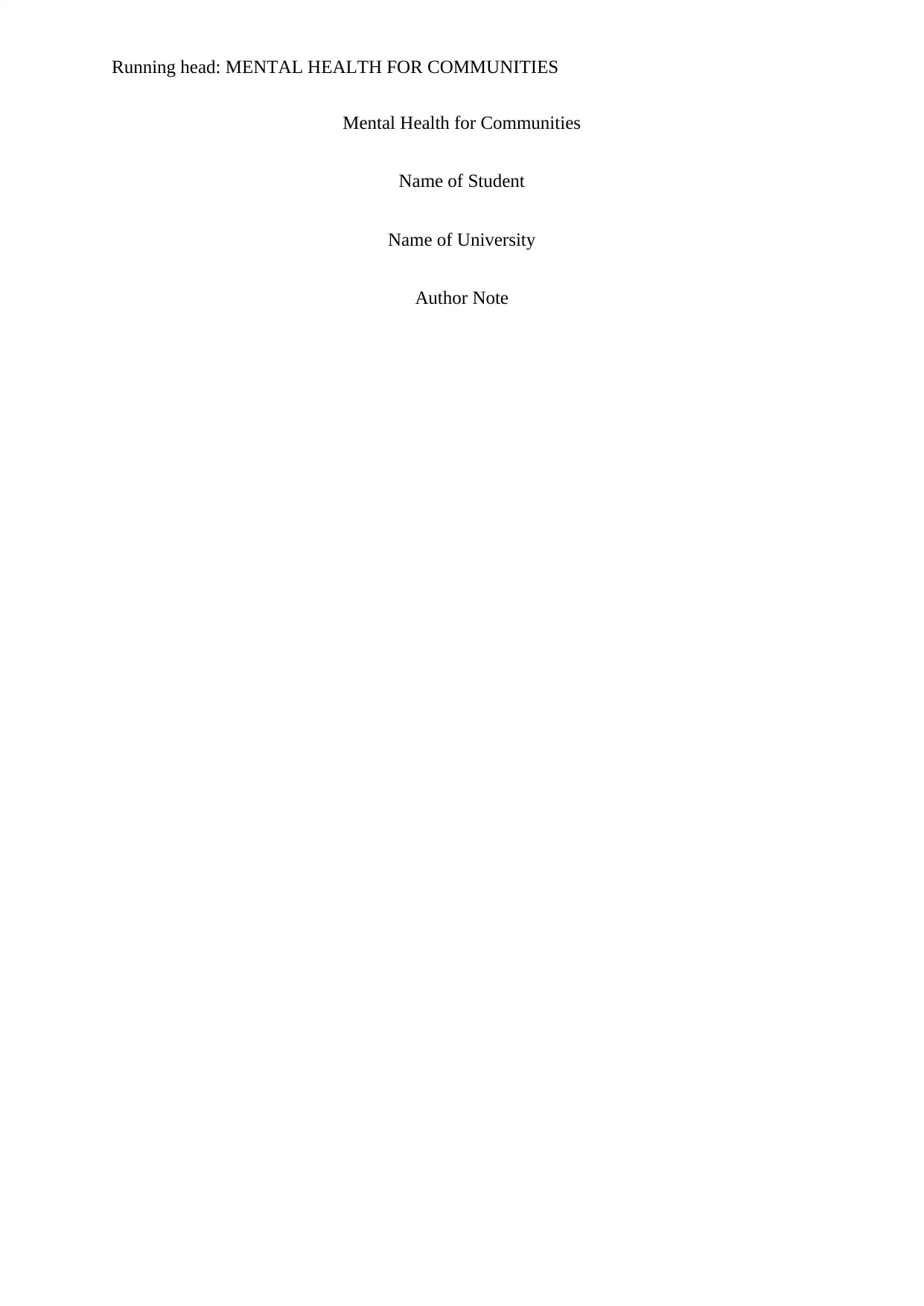
Running head: MENTAL HEALTH FOR COMMUNITIES
Mental Health for Communities
Name of Student
Name of University
Author Note
Mental Health for Communities
Name of Student
Name of University
Author Note
Paraphrase This Document
Need a fresh take? Get an instant paraphrase of this document with our AI Paraphraser
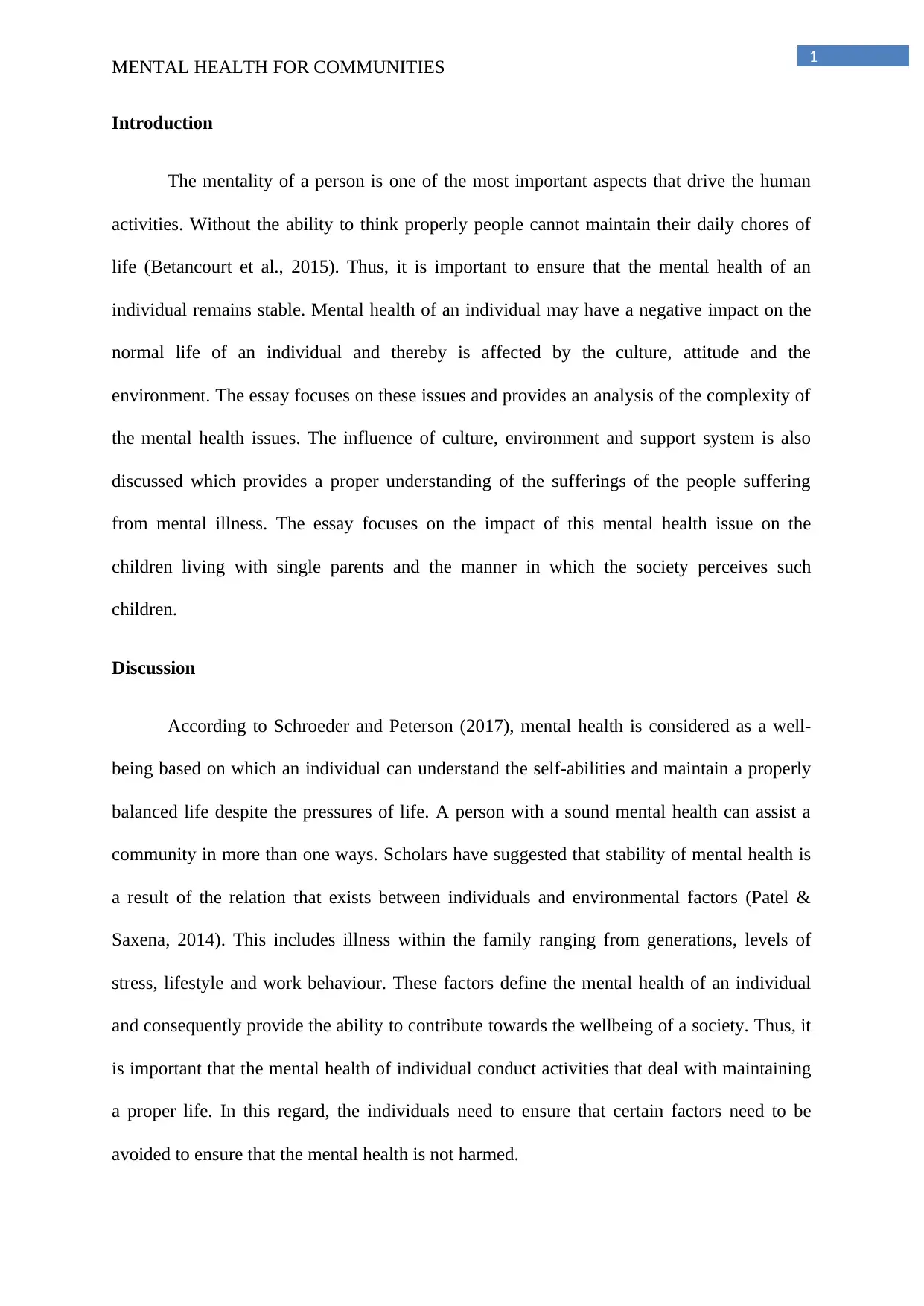
1
MENTAL HEALTH FOR COMMUNITIES
Introduction
The mentality of a person is one of the most important aspects that drive the human
activities. Without the ability to think properly people cannot maintain their daily chores of
life (Betancourt et al., 2015). Thus, it is important to ensure that the mental health of an
individual remains stable. Mental health of an individual may have a negative impact on the
normal life of an individual and thereby is affected by the culture, attitude and the
environment. The essay focuses on these issues and provides an analysis of the complexity of
the mental health issues. The influence of culture, environment and support system is also
discussed which provides a proper understanding of the sufferings of the people suffering
from mental illness. The essay focuses on the impact of this mental health issue on the
children living with single parents and the manner in which the society perceives such
children.
Discussion
According to Schroeder and Peterson (2017), mental health is considered as a well-
being based on which an individual can understand the self-abilities and maintain a properly
balanced life despite the pressures of life. A person with a sound mental health can assist a
community in more than one ways. Scholars have suggested that stability of mental health is
a result of the relation that exists between individuals and environmental factors (Patel &
Saxena, 2014). This includes illness within the family ranging from generations, levels of
stress, lifestyle and work behaviour. These factors define the mental health of an individual
and consequently provide the ability to contribute towards the wellbeing of a society. Thus, it
is important that the mental health of individual conduct activities that deal with maintaining
a proper life. In this regard, the individuals need to ensure that certain factors need to be
avoided to ensure that the mental health is not harmed.
MENTAL HEALTH FOR COMMUNITIES
Introduction
The mentality of a person is one of the most important aspects that drive the human
activities. Without the ability to think properly people cannot maintain their daily chores of
life (Betancourt et al., 2015). Thus, it is important to ensure that the mental health of an
individual remains stable. Mental health of an individual may have a negative impact on the
normal life of an individual and thereby is affected by the culture, attitude and the
environment. The essay focuses on these issues and provides an analysis of the complexity of
the mental health issues. The influence of culture, environment and support system is also
discussed which provides a proper understanding of the sufferings of the people suffering
from mental illness. The essay focuses on the impact of this mental health issue on the
children living with single parents and the manner in which the society perceives such
children.
Discussion
According to Schroeder and Peterson (2017), mental health is considered as a well-
being based on which an individual can understand the self-abilities and maintain a properly
balanced life despite the pressures of life. A person with a sound mental health can assist a
community in more than one ways. Scholars have suggested that stability of mental health is
a result of the relation that exists between individuals and environmental factors (Patel &
Saxena, 2014). This includes illness within the family ranging from generations, levels of
stress, lifestyle and work behaviour. These factors define the mental health of an individual
and consequently provide the ability to contribute towards the wellbeing of a society. Thus, it
is important that the mental health of individual conduct activities that deal with maintaining
a proper life. In this regard, the individuals need to ensure that certain factors need to be
avoided to ensure that the mental health is not harmed.
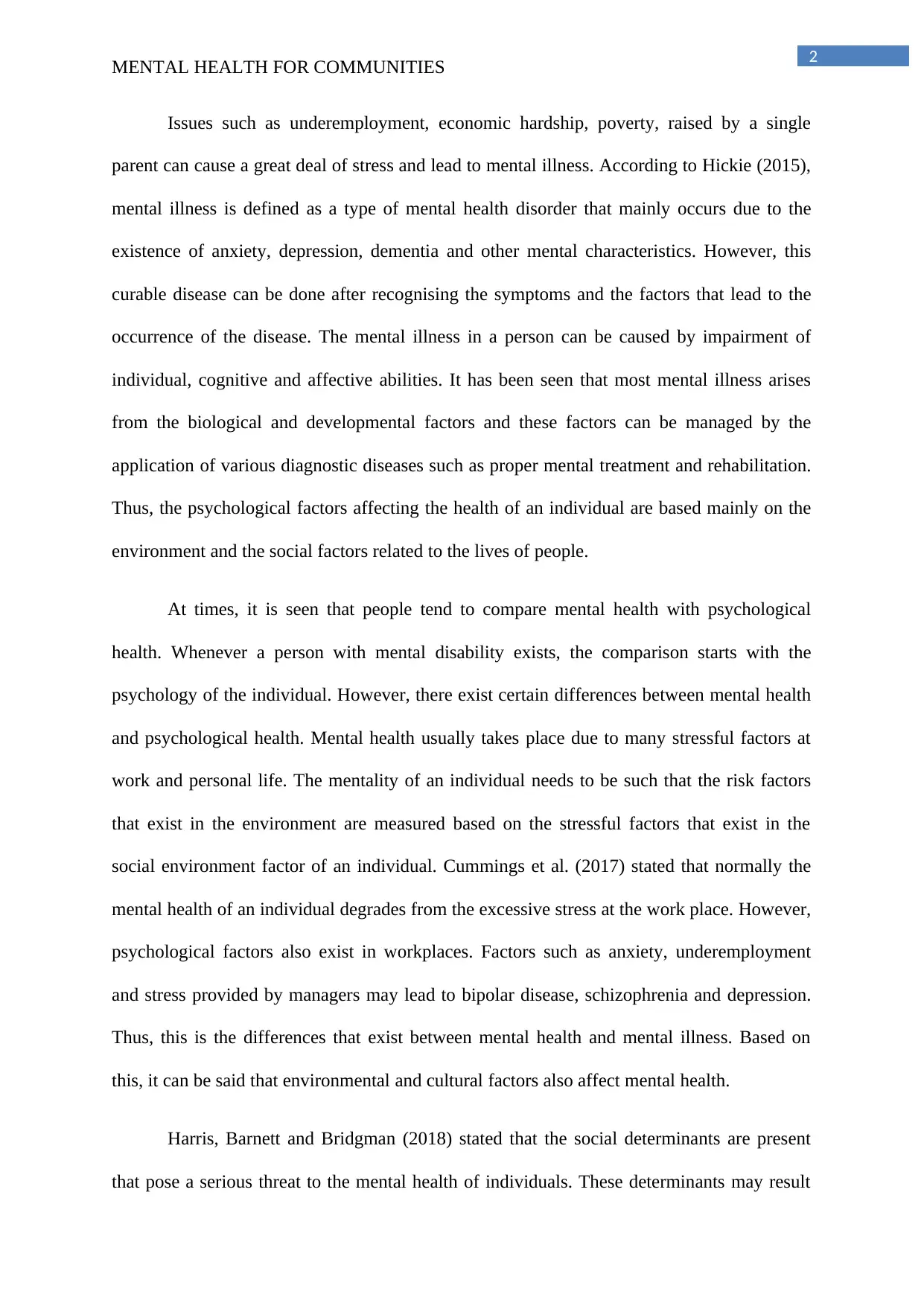
2
MENTAL HEALTH FOR COMMUNITIES
Issues such as underemployment, economic hardship, poverty, raised by a single
parent can cause a great deal of stress and lead to mental illness. According to Hickie (2015),
mental illness is defined as a type of mental health disorder that mainly occurs due to the
existence of anxiety, depression, dementia and other mental characteristics. However, this
curable disease can be done after recognising the symptoms and the factors that lead to the
occurrence of the disease. The mental illness in a person can be caused by impairment of
individual, cognitive and affective abilities. It has been seen that most mental illness arises
from the biological and developmental factors and these factors can be managed by the
application of various diagnostic diseases such as proper mental treatment and rehabilitation.
Thus, the psychological factors affecting the health of an individual are based mainly on the
environment and the social factors related to the lives of people.
At times, it is seen that people tend to compare mental health with psychological
health. Whenever a person with mental disability exists, the comparison starts with the
psychology of the individual. However, there exist certain differences between mental health
and psychological health. Mental health usually takes place due to many stressful factors at
work and personal life. The mentality of an individual needs to be such that the risk factors
that exist in the environment are measured based on the stressful factors that exist in the
social environment factor of an individual. Cummings et al. (2017) stated that normally the
mental health of an individual degrades from the excessive stress at the work place. However,
psychological factors also exist in workplaces. Factors such as anxiety, underemployment
and stress provided by managers may lead to bipolar disease, schizophrenia and depression.
Thus, this is the differences that exist between mental health and mental illness. Based on
this, it can be said that environmental and cultural factors also affect mental health.
Harris, Barnett and Bridgman (2018) stated that the social determinants are present
that pose a serious threat to the mental health of individuals. These determinants may result
MENTAL HEALTH FOR COMMUNITIES
Issues such as underemployment, economic hardship, poverty, raised by a single
parent can cause a great deal of stress and lead to mental illness. According to Hickie (2015),
mental illness is defined as a type of mental health disorder that mainly occurs due to the
existence of anxiety, depression, dementia and other mental characteristics. However, this
curable disease can be done after recognising the symptoms and the factors that lead to the
occurrence of the disease. The mental illness in a person can be caused by impairment of
individual, cognitive and affective abilities. It has been seen that most mental illness arises
from the biological and developmental factors and these factors can be managed by the
application of various diagnostic diseases such as proper mental treatment and rehabilitation.
Thus, the psychological factors affecting the health of an individual are based mainly on the
environment and the social factors related to the lives of people.
At times, it is seen that people tend to compare mental health with psychological
health. Whenever a person with mental disability exists, the comparison starts with the
psychology of the individual. However, there exist certain differences between mental health
and psychological health. Mental health usually takes place due to many stressful factors at
work and personal life. The mentality of an individual needs to be such that the risk factors
that exist in the environment are measured based on the stressful factors that exist in the
social environment factor of an individual. Cummings et al. (2017) stated that normally the
mental health of an individual degrades from the excessive stress at the work place. However,
psychological factors also exist in workplaces. Factors such as anxiety, underemployment
and stress provided by managers may lead to bipolar disease, schizophrenia and depression.
Thus, this is the differences that exist between mental health and mental illness. Based on
this, it can be said that environmental and cultural factors also affect mental health.
Harris, Barnett and Bridgman (2018) stated that the social determinants are present
that pose a serious threat to the mental health of individuals. These determinants may result
⊘ This is a preview!⊘
Do you want full access?
Subscribe today to unlock all pages.

Trusted by 1+ million students worldwide
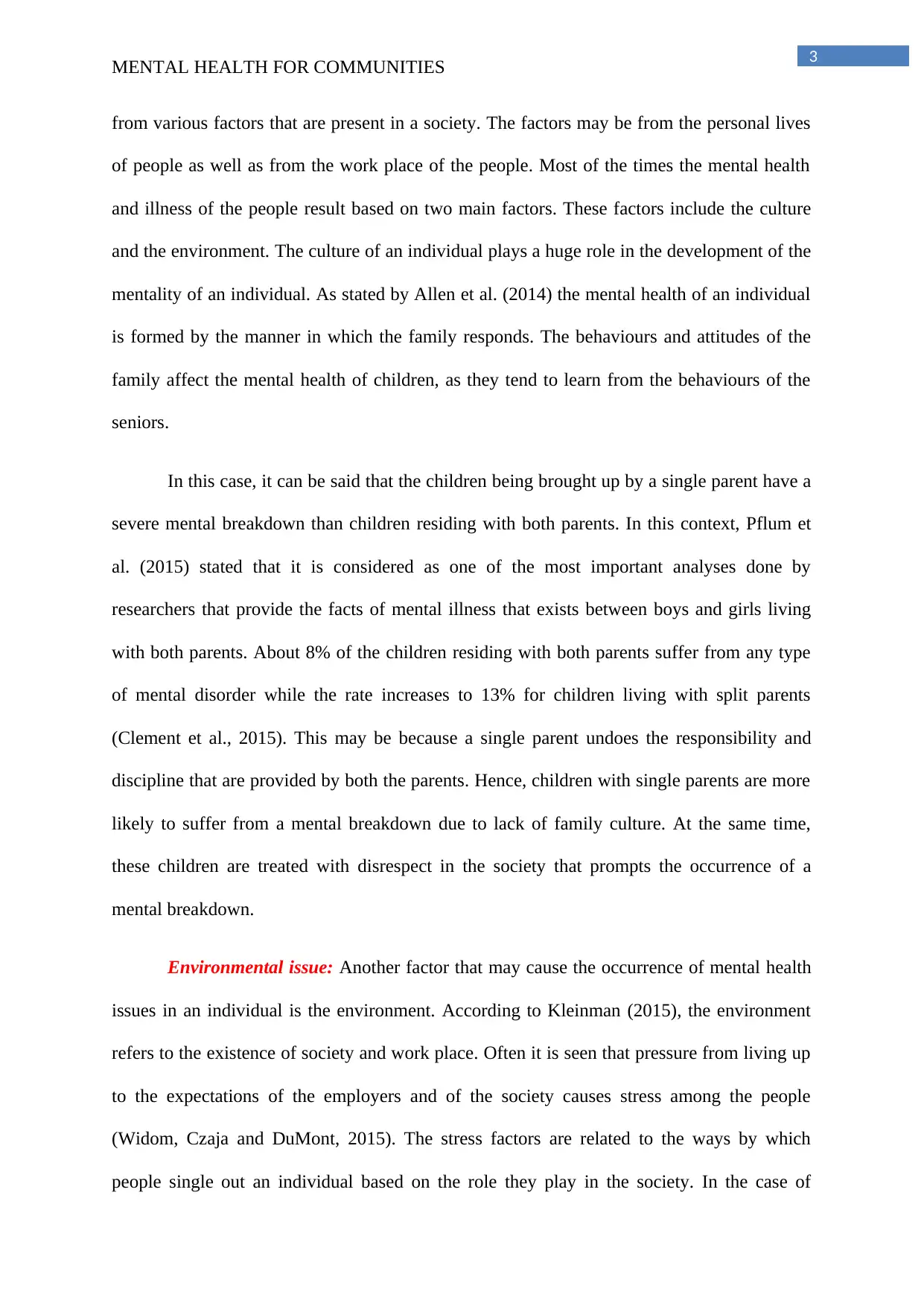
3
MENTAL HEALTH FOR COMMUNITIES
from various factors that are present in a society. The factors may be from the personal lives
of people as well as from the work place of the people. Most of the times the mental health
and illness of the people result based on two main factors. These factors include the culture
and the environment. The culture of an individual plays a huge role in the development of the
mentality of an individual. As stated by Allen et al. (2014) the mental health of an individual
is formed by the manner in which the family responds. The behaviours and attitudes of the
family affect the mental health of children, as they tend to learn from the behaviours of the
seniors.
In this case, it can be said that the children being brought up by a single parent have a
severe mental breakdown than children residing with both parents. In this context, Pflum et
al. (2015) stated that it is considered as one of the most important analyses done by
researchers that provide the facts of mental illness that exists between boys and girls living
with both parents. About 8% of the children residing with both parents suffer from any type
of mental disorder while the rate increases to 13% for children living with split parents
(Clement et al., 2015). This may be because a single parent undoes the responsibility and
discipline that are provided by both the parents. Hence, children with single parents are more
likely to suffer from a mental breakdown due to lack of family culture. At the same time,
these children are treated with disrespect in the society that prompts the occurrence of a
mental breakdown.
Environmental issue: Another factor that may cause the occurrence of mental health
issues in an individual is the environment. According to Kleinman (2015), the environment
refers to the existence of society and work place. Often it is seen that pressure from living up
to the expectations of the employers and of the society causes stress among the people
(Widom, Czaja and DuMont, 2015). The stress factors are related to the ways by which
people single out an individual based on the role they play in the society. In the case of
MENTAL HEALTH FOR COMMUNITIES
from various factors that are present in a society. The factors may be from the personal lives
of people as well as from the work place of the people. Most of the times the mental health
and illness of the people result based on two main factors. These factors include the culture
and the environment. The culture of an individual plays a huge role in the development of the
mentality of an individual. As stated by Allen et al. (2014) the mental health of an individual
is formed by the manner in which the family responds. The behaviours and attitudes of the
family affect the mental health of children, as they tend to learn from the behaviours of the
seniors.
In this case, it can be said that the children being brought up by a single parent have a
severe mental breakdown than children residing with both parents. In this context, Pflum et
al. (2015) stated that it is considered as one of the most important analyses done by
researchers that provide the facts of mental illness that exists between boys and girls living
with both parents. About 8% of the children residing with both parents suffer from any type
of mental disorder while the rate increases to 13% for children living with split parents
(Clement et al., 2015). This may be because a single parent undoes the responsibility and
discipline that are provided by both the parents. Hence, children with single parents are more
likely to suffer from a mental breakdown due to lack of family culture. At the same time,
these children are treated with disrespect in the society that prompts the occurrence of a
mental breakdown.
Environmental issue: Another factor that may cause the occurrence of mental health
issues in an individual is the environment. According to Kleinman (2015), the environment
refers to the existence of society and work place. Often it is seen that pressure from living up
to the expectations of the employers and of the society causes stress among the people
(Widom, Czaja and DuMont, 2015). The stress factors are related to the ways by which
people single out an individual based on the role they play in the society. In the case of
Paraphrase This Document
Need a fresh take? Get an instant paraphrase of this document with our AI Paraphraser
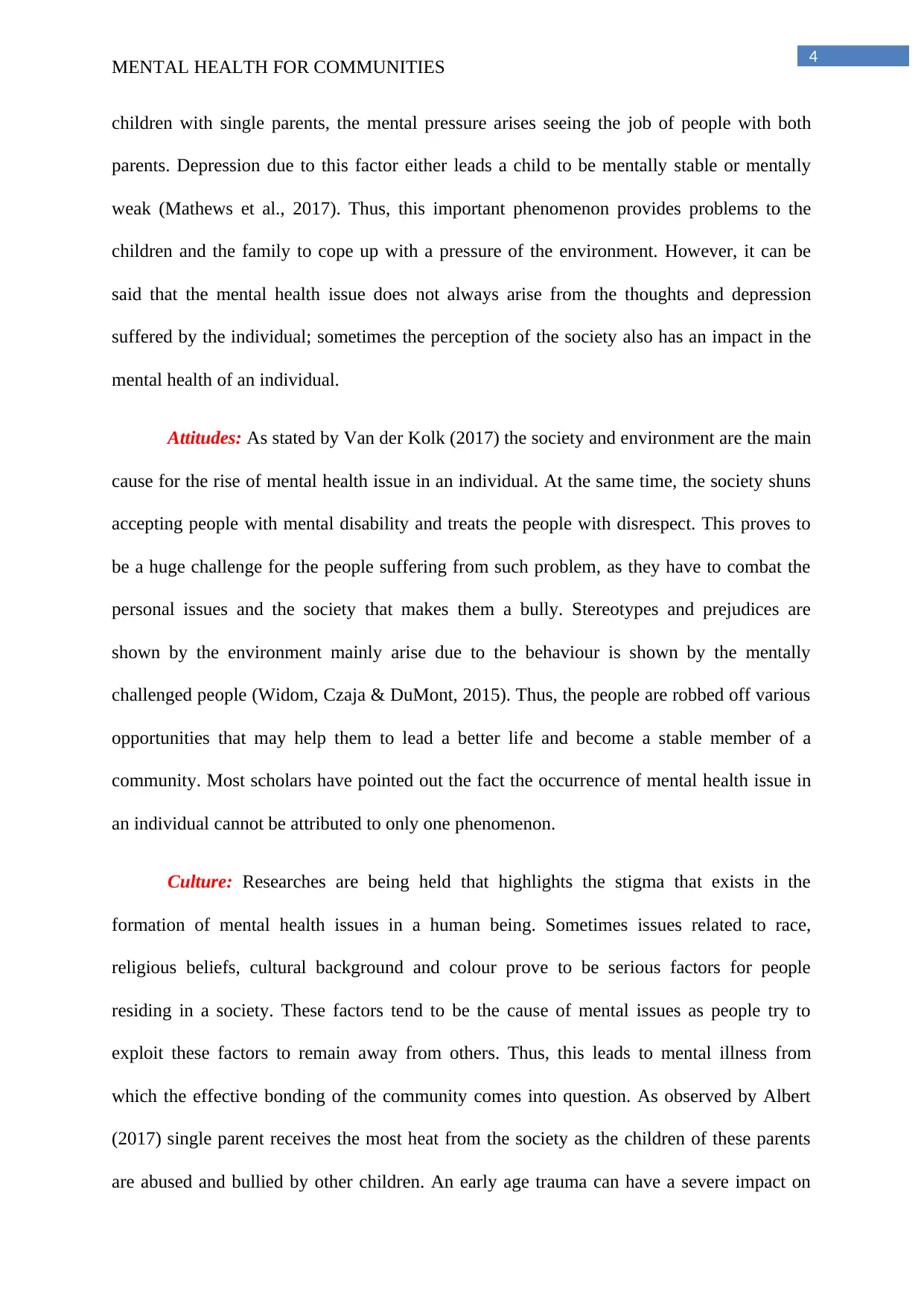
4
MENTAL HEALTH FOR COMMUNITIES
children with single parents, the mental pressure arises seeing the job of people with both
parents. Depression due to this factor either leads a child to be mentally stable or mentally
weak (Mathews et al., 2017). Thus, this important phenomenon provides problems to the
children and the family to cope up with a pressure of the environment. However, it can be
said that the mental health issue does not always arise from the thoughts and depression
suffered by the individual; sometimes the perception of the society also has an impact in the
mental health of an individual.
Attitudes: As stated by Van der Kolk (2017) the society and environment are the main
cause for the rise of mental health issue in an individual. At the same time, the society shuns
accepting people with mental disability and treats the people with disrespect. This proves to
be a huge challenge for the people suffering from such problem, as they have to combat the
personal issues and the society that makes them a bully. Stereotypes and prejudices are
shown by the environment mainly arise due to the behaviour is shown by the mentally
challenged people (Widom, Czaja & DuMont, 2015). Thus, the people are robbed off various
opportunities that may help them to lead a better life and become a stable member of a
community. Most scholars have pointed out the fact the occurrence of mental health issue in
an individual cannot be attributed to only one phenomenon.
Culture: Researches are being held that highlights the stigma that exists in the
formation of mental health issues in a human being. Sometimes issues related to race,
religious beliefs, cultural background and colour prove to be serious factors for people
residing in a society. These factors tend to be the cause of mental issues as people try to
exploit these factors to remain away from others. Thus, this leads to mental illness from
which the effective bonding of the community comes into question. As observed by Albert
(2017) single parent receives the most heat from the society as the children of these parents
are abused and bullied by other children. An early age trauma can have a severe impact on
MENTAL HEALTH FOR COMMUNITIES
children with single parents, the mental pressure arises seeing the job of people with both
parents. Depression due to this factor either leads a child to be mentally stable or mentally
weak (Mathews et al., 2017). Thus, this important phenomenon provides problems to the
children and the family to cope up with a pressure of the environment. However, it can be
said that the mental health issue does not always arise from the thoughts and depression
suffered by the individual; sometimes the perception of the society also has an impact in the
mental health of an individual.
Attitudes: As stated by Van der Kolk (2017) the society and environment are the main
cause for the rise of mental health issue in an individual. At the same time, the society shuns
accepting people with mental disability and treats the people with disrespect. This proves to
be a huge challenge for the people suffering from such problem, as they have to combat the
personal issues and the society that makes them a bully. Stereotypes and prejudices are
shown by the environment mainly arise due to the behaviour is shown by the mentally
challenged people (Widom, Czaja & DuMont, 2015). Thus, the people are robbed off various
opportunities that may help them to lead a better life and become a stable member of a
community. Most scholars have pointed out the fact the occurrence of mental health issue in
an individual cannot be attributed to only one phenomenon.
Culture: Researches are being held that highlights the stigma that exists in the
formation of mental health issues in a human being. Sometimes issues related to race,
religious beliefs, cultural background and colour prove to be serious factors for people
residing in a society. These factors tend to be the cause of mental issues as people try to
exploit these factors to remain away from others. Thus, this leads to mental illness from
which the effective bonding of the community comes into question. As observed by Albert
(2017) single parent receives the most heat from the society as the children of these parents
are abused and bullied by other children. An early age trauma can have a severe impact on
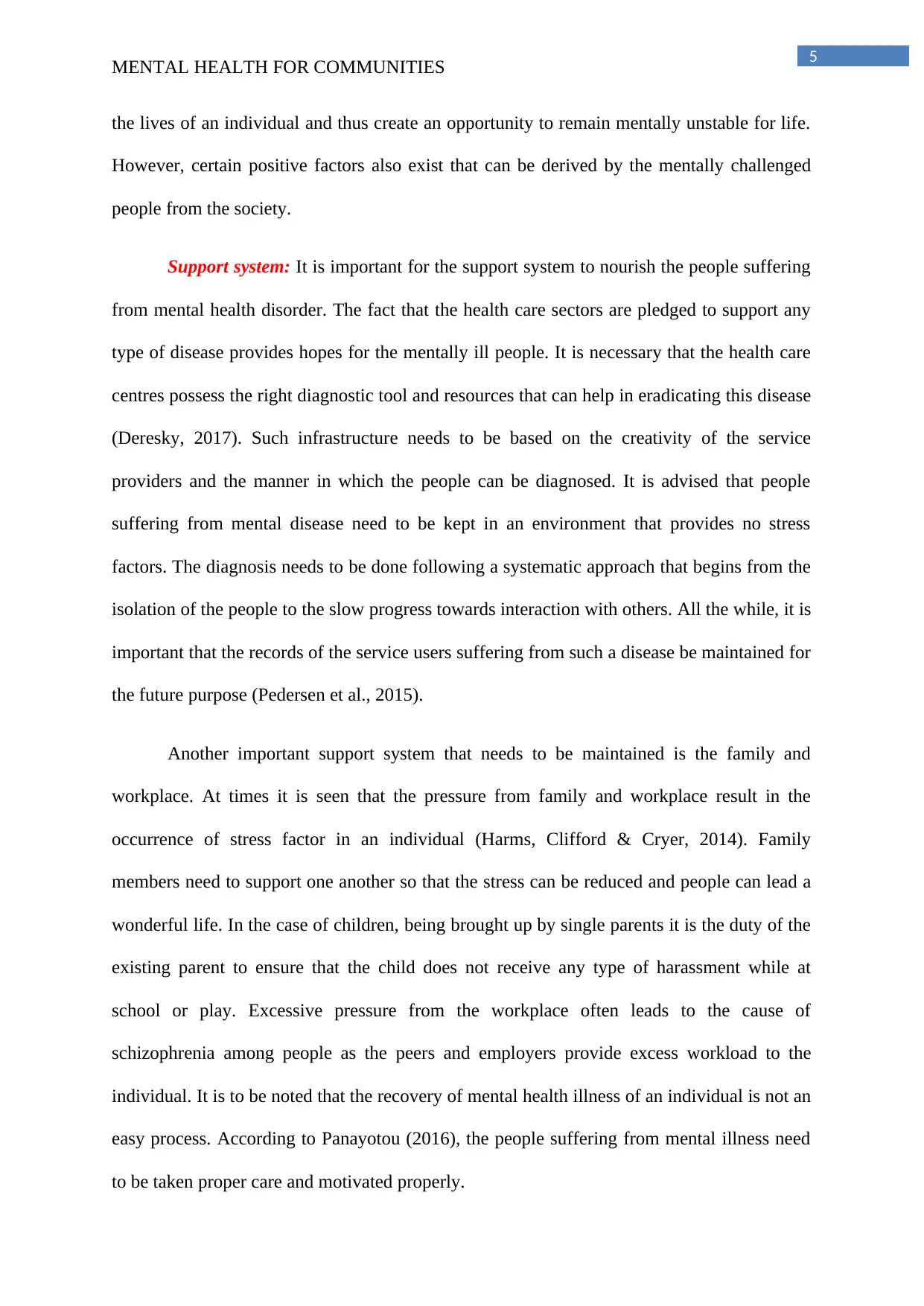
5
MENTAL HEALTH FOR COMMUNITIES
the lives of an individual and thus create an opportunity to remain mentally unstable for life.
However, certain positive factors also exist that can be derived by the mentally challenged
people from the society.
Support system: It is important for the support system to nourish the people suffering
from mental health disorder. The fact that the health care sectors are pledged to support any
type of disease provides hopes for the mentally ill people. It is necessary that the health care
centres possess the right diagnostic tool and resources that can help in eradicating this disease
(Deresky, 2017). Such infrastructure needs to be based on the creativity of the service
providers and the manner in which the people can be diagnosed. It is advised that people
suffering from mental disease need to be kept in an environment that provides no stress
factors. The diagnosis needs to be done following a systematic approach that begins from the
isolation of the people to the slow progress towards interaction with others. All the while, it is
important that the records of the service users suffering from such a disease be maintained for
the future purpose (Pedersen et al., 2015).
Another important support system that needs to be maintained is the family and
workplace. At times it is seen that the pressure from family and workplace result in the
occurrence of stress factor in an individual (Harms, Clifford & Cryer, 2014). Family
members need to support one another so that the stress can be reduced and people can lead a
wonderful life. In the case of children, being brought up by single parents it is the duty of the
existing parent to ensure that the child does not receive any type of harassment while at
school or play. Excessive pressure from the workplace often leads to the cause of
schizophrenia among people as the peers and employers provide excess workload to the
individual. It is to be noted that the recovery of mental health illness of an individual is not an
easy process. According to Panayotou (2016), the people suffering from mental illness need
to be taken proper care and motivated properly.
MENTAL HEALTH FOR COMMUNITIES
the lives of an individual and thus create an opportunity to remain mentally unstable for life.
However, certain positive factors also exist that can be derived by the mentally challenged
people from the society.
Support system: It is important for the support system to nourish the people suffering
from mental health disorder. The fact that the health care sectors are pledged to support any
type of disease provides hopes for the mentally ill people. It is necessary that the health care
centres possess the right diagnostic tool and resources that can help in eradicating this disease
(Deresky, 2017). Such infrastructure needs to be based on the creativity of the service
providers and the manner in which the people can be diagnosed. It is advised that people
suffering from mental disease need to be kept in an environment that provides no stress
factors. The diagnosis needs to be done following a systematic approach that begins from the
isolation of the people to the slow progress towards interaction with others. All the while, it is
important that the records of the service users suffering from such a disease be maintained for
the future purpose (Pedersen et al., 2015).
Another important support system that needs to be maintained is the family and
workplace. At times it is seen that the pressure from family and workplace result in the
occurrence of stress factor in an individual (Harms, Clifford & Cryer, 2014). Family
members need to support one another so that the stress can be reduced and people can lead a
wonderful life. In the case of children, being brought up by single parents it is the duty of the
existing parent to ensure that the child does not receive any type of harassment while at
school or play. Excessive pressure from the workplace often leads to the cause of
schizophrenia among people as the peers and employers provide excess workload to the
individual. It is to be noted that the recovery of mental health illness of an individual is not an
easy process. According to Panayotou (2016), the people suffering from mental illness need
to be taken proper care and motivated properly.
⊘ This is a preview!⊘
Do you want full access?
Subscribe today to unlock all pages.

Trusted by 1+ million students worldwide
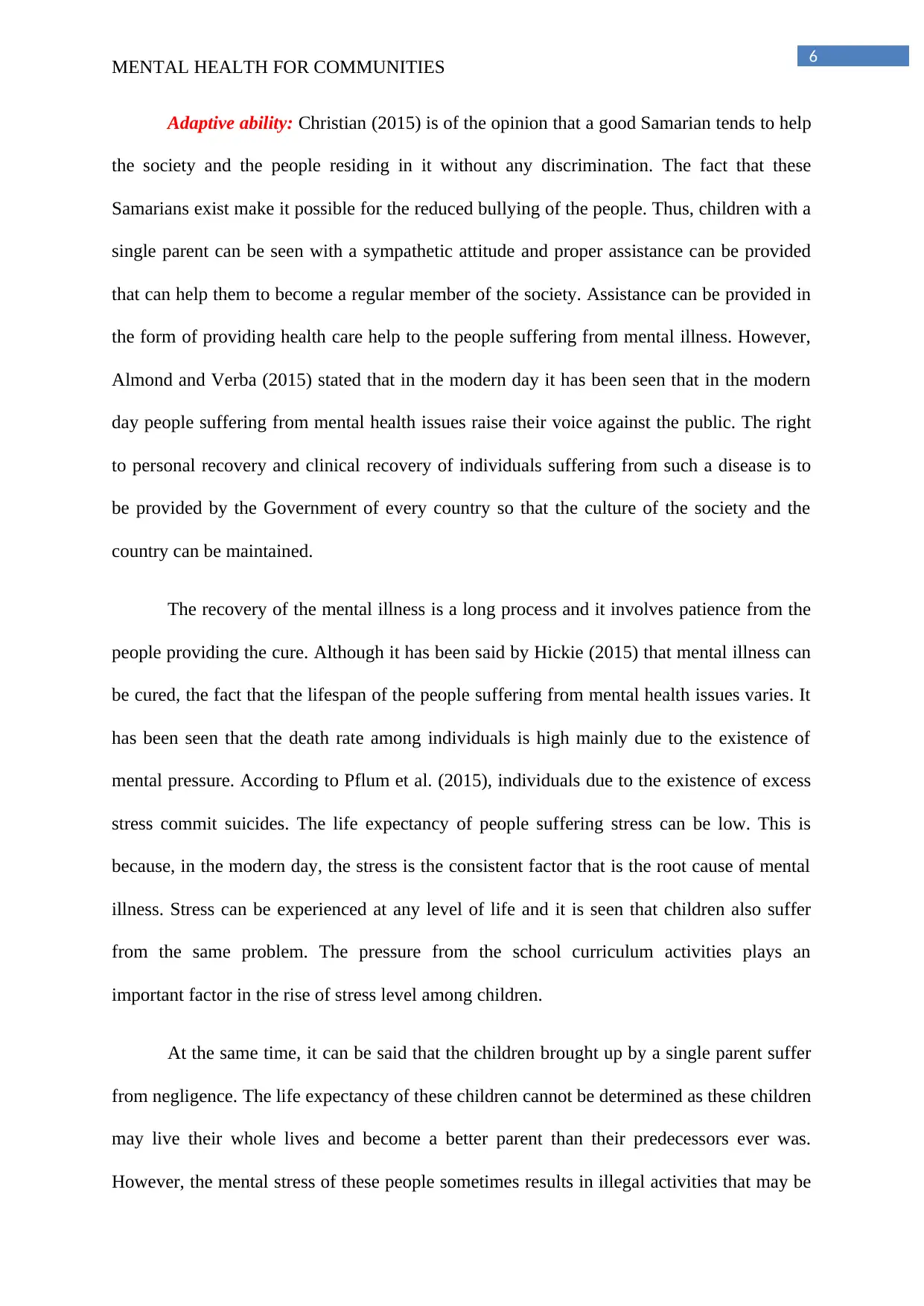
6
MENTAL HEALTH FOR COMMUNITIES
Adaptive ability: Christian (2015) is of the opinion that a good Samarian tends to help
the society and the people residing in it without any discrimination. The fact that these
Samarians exist make it possible for the reduced bullying of the people. Thus, children with a
single parent can be seen with a sympathetic attitude and proper assistance can be provided
that can help them to become a regular member of the society. Assistance can be provided in
the form of providing health care help to the people suffering from mental illness. However,
Almond and Verba (2015) stated that in the modern day it has been seen that in the modern
day people suffering from mental health issues raise their voice against the public. The right
to personal recovery and clinical recovery of individuals suffering from such a disease is to
be provided by the Government of every country so that the culture of the society and the
country can be maintained.
The recovery of the mental illness is a long process and it involves patience from the
people providing the cure. Although it has been said by Hickie (2015) that mental illness can
be cured, the fact that the lifespan of the people suffering from mental health issues varies. It
has been seen that the death rate among individuals is high mainly due to the existence of
mental pressure. According to Pflum et al. (2015), individuals due to the existence of excess
stress commit suicides. The life expectancy of people suffering stress can be low. This is
because, in the modern day, the stress is the consistent factor that is the root cause of mental
illness. Stress can be experienced at any level of life and it is seen that children also suffer
from the same problem. The pressure from the school curriculum activities plays an
important factor in the rise of stress level among children.
At the same time, it can be said that the children brought up by a single parent suffer
from negligence. The life expectancy of these children cannot be determined as these children
may live their whole lives and become a better parent than their predecessors ever was.
However, the mental stress of these people sometimes results in illegal activities that may be
MENTAL HEALTH FOR COMMUNITIES
Adaptive ability: Christian (2015) is of the opinion that a good Samarian tends to help
the society and the people residing in it without any discrimination. The fact that these
Samarians exist make it possible for the reduced bullying of the people. Thus, children with a
single parent can be seen with a sympathetic attitude and proper assistance can be provided
that can help them to become a regular member of the society. Assistance can be provided in
the form of providing health care help to the people suffering from mental illness. However,
Almond and Verba (2015) stated that in the modern day it has been seen that in the modern
day people suffering from mental health issues raise their voice against the public. The right
to personal recovery and clinical recovery of individuals suffering from such a disease is to
be provided by the Government of every country so that the culture of the society and the
country can be maintained.
The recovery of the mental illness is a long process and it involves patience from the
people providing the cure. Although it has been said by Hickie (2015) that mental illness can
be cured, the fact that the lifespan of the people suffering from mental health issues varies. It
has been seen that the death rate among individuals is high mainly due to the existence of
mental pressure. According to Pflum et al. (2015), individuals due to the existence of excess
stress commit suicides. The life expectancy of people suffering stress can be low. This is
because, in the modern day, the stress is the consistent factor that is the root cause of mental
illness. Stress can be experienced at any level of life and it is seen that children also suffer
from the same problem. The pressure from the school curriculum activities plays an
important factor in the rise of stress level among children.
At the same time, it can be said that the children brought up by a single parent suffer
from negligence. The life expectancy of these children cannot be determined as these children
may live their whole lives and become a better parent than their predecessors ever was.
However, the mental stress of these people sometimes results in illegal activities that may be
Paraphrase This Document
Need a fresh take? Get an instant paraphrase of this document with our AI Paraphraser
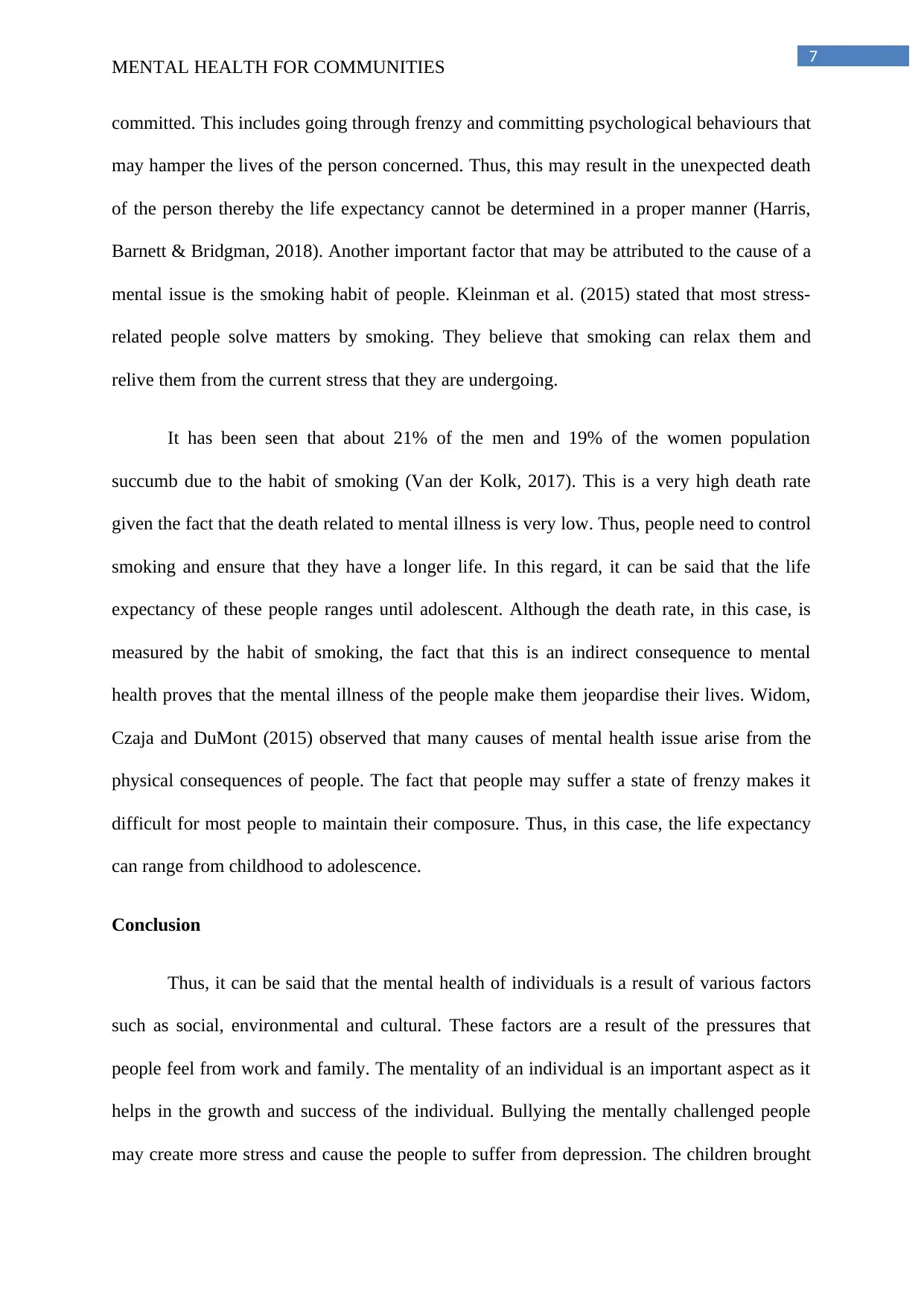
7
MENTAL HEALTH FOR COMMUNITIES
committed. This includes going through frenzy and committing psychological behaviours that
may hamper the lives of the person concerned. Thus, this may result in the unexpected death
of the person thereby the life expectancy cannot be determined in a proper manner (Harris,
Barnett & Bridgman, 2018). Another important factor that may be attributed to the cause of a
mental issue is the smoking habit of people. Kleinman et al. (2015) stated that most stress-
related people solve matters by smoking. They believe that smoking can relax them and
relive them from the current stress that they are undergoing.
It has been seen that about 21% of the men and 19% of the women population
succumb due to the habit of smoking (Van der Kolk, 2017). This is a very high death rate
given the fact that the death related to mental illness is very low. Thus, people need to control
smoking and ensure that they have a longer life. In this regard, it can be said that the life
expectancy of these people ranges until adolescent. Although the death rate, in this case, is
measured by the habit of smoking, the fact that this is an indirect consequence to mental
health proves that the mental illness of the people make them jeopardise their lives. Widom,
Czaja and DuMont (2015) observed that many causes of mental health issue arise from the
physical consequences of people. The fact that people may suffer a state of frenzy makes it
difficult for most people to maintain their composure. Thus, in this case, the life expectancy
can range from childhood to adolescence.
Conclusion
Thus, it can be said that the mental health of individuals is a result of various factors
such as social, environmental and cultural. These factors are a result of the pressures that
people feel from work and family. The mentality of an individual is an important aspect as it
helps in the growth and success of the individual. Bullying the mentally challenged people
may create more stress and cause the people to suffer from depression. The children brought
MENTAL HEALTH FOR COMMUNITIES
committed. This includes going through frenzy and committing psychological behaviours that
may hamper the lives of the person concerned. Thus, this may result in the unexpected death
of the person thereby the life expectancy cannot be determined in a proper manner (Harris,
Barnett & Bridgman, 2018). Another important factor that may be attributed to the cause of a
mental issue is the smoking habit of people. Kleinman et al. (2015) stated that most stress-
related people solve matters by smoking. They believe that smoking can relax them and
relive them from the current stress that they are undergoing.
It has been seen that about 21% of the men and 19% of the women population
succumb due to the habit of smoking (Van der Kolk, 2017). This is a very high death rate
given the fact that the death related to mental illness is very low. Thus, people need to control
smoking and ensure that they have a longer life. In this regard, it can be said that the life
expectancy of these people ranges until adolescent. Although the death rate, in this case, is
measured by the habit of smoking, the fact that this is an indirect consequence to mental
health proves that the mental illness of the people make them jeopardise their lives. Widom,
Czaja and DuMont (2015) observed that many causes of mental health issue arise from the
physical consequences of people. The fact that people may suffer a state of frenzy makes it
difficult for most people to maintain their composure. Thus, in this case, the life expectancy
can range from childhood to adolescence.
Conclusion
Thus, it can be said that the mental health of individuals is a result of various factors
such as social, environmental and cultural. These factors are a result of the pressures that
people feel from work and family. The mentality of an individual is an important aspect as it
helps in the growth and success of the individual. Bullying the mentally challenged people
may create more stress and cause the people to suffer from depression. The children brought
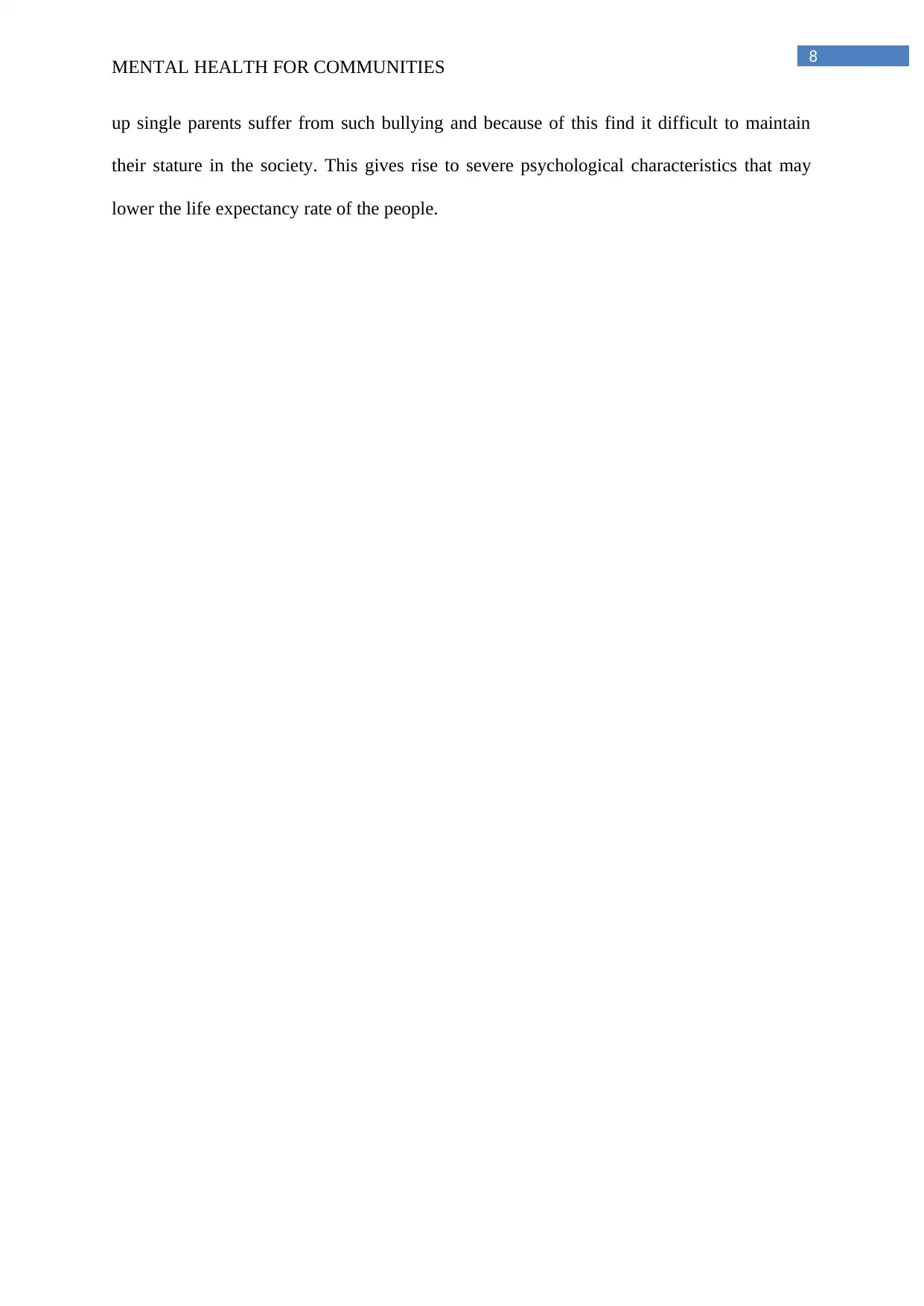
8
MENTAL HEALTH FOR COMMUNITIES
up single parents suffer from such bullying and because of this find it difficult to maintain
their stature in the society. This gives rise to severe psychological characteristics that may
lower the life expectancy rate of the people.
MENTAL HEALTH FOR COMMUNITIES
up single parents suffer from such bullying and because of this find it difficult to maintain
their stature in the society. This gives rise to severe psychological characteristics that may
lower the life expectancy rate of the people.
⊘ This is a preview!⊘
Do you want full access?
Subscribe today to unlock all pages.

Trusted by 1+ million students worldwide
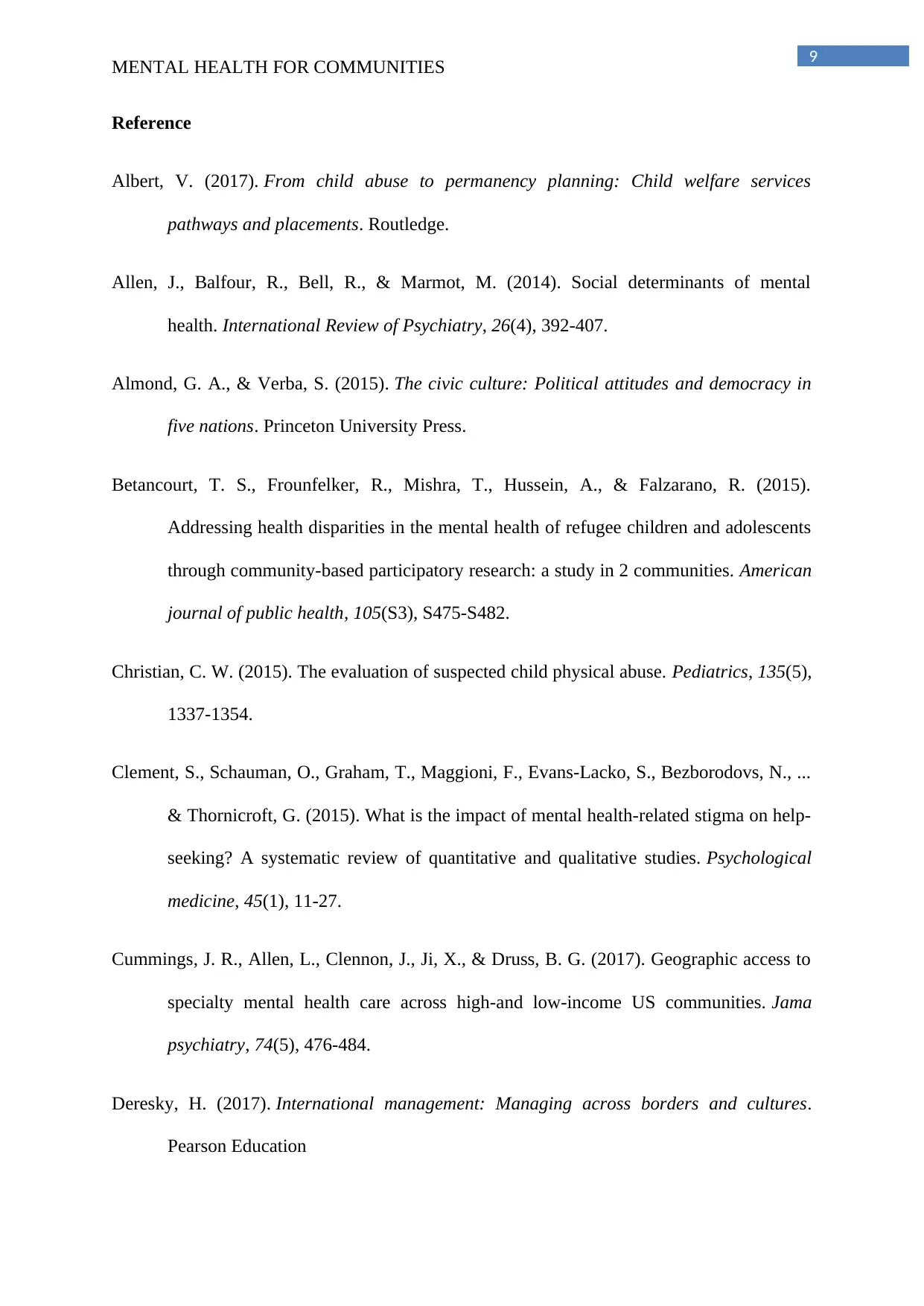
9
MENTAL HEALTH FOR COMMUNITIES
Reference
Albert, V. (2017). From child abuse to permanency planning: Child welfare services
pathways and placements. Routledge.
Allen, J., Balfour, R., Bell, R., & Marmot, M. (2014). Social determinants of mental
health. International Review of Psychiatry, 26(4), 392-407.
Almond, G. A., & Verba, S. (2015). The civic culture: Political attitudes and democracy in
five nations. Princeton University Press.
Betancourt, T. S., Frounfelker, R., Mishra, T., Hussein, A., & Falzarano, R. (2015).
Addressing health disparities in the mental health of refugee children and adolescents
through community-based participatory research: a study in 2 communities. American
journal of public health, 105(S3), S475-S482.
Christian, C. W. (2015). The evaluation of suspected child physical abuse. Pediatrics, 135(5),
1337-1354.
Clement, S., Schauman, O., Graham, T., Maggioni, F., Evans-Lacko, S., Bezborodovs, N., ...
& Thornicroft, G. (2015). What is the impact of mental health-related stigma on help-
seeking? A systematic review of quantitative and qualitative studies. Psychological
medicine, 45(1), 11-27.
Cummings, J. R., Allen, L., Clennon, J., Ji, X., & Druss, B. G. (2017). Geographic access to
specialty mental health care across high-and low-income US communities. Jama
psychiatry, 74(5), 476-484.
Deresky, H. (2017). International management: Managing across borders and cultures.
Pearson Education
MENTAL HEALTH FOR COMMUNITIES
Reference
Albert, V. (2017). From child abuse to permanency planning: Child welfare services
pathways and placements. Routledge.
Allen, J., Balfour, R., Bell, R., & Marmot, M. (2014). Social determinants of mental
health. International Review of Psychiatry, 26(4), 392-407.
Almond, G. A., & Verba, S. (2015). The civic culture: Political attitudes and democracy in
five nations. Princeton University Press.
Betancourt, T. S., Frounfelker, R., Mishra, T., Hussein, A., & Falzarano, R. (2015).
Addressing health disparities in the mental health of refugee children and adolescents
through community-based participatory research: a study in 2 communities. American
journal of public health, 105(S3), S475-S482.
Christian, C. W. (2015). The evaluation of suspected child physical abuse. Pediatrics, 135(5),
1337-1354.
Clement, S., Schauman, O., Graham, T., Maggioni, F., Evans-Lacko, S., Bezborodovs, N., ...
& Thornicroft, G. (2015). What is the impact of mental health-related stigma on help-
seeking? A systematic review of quantitative and qualitative studies. Psychological
medicine, 45(1), 11-27.
Cummings, J. R., Allen, L., Clennon, J., Ji, X., & Druss, B. G. (2017). Geographic access to
specialty mental health care across high-and low-income US communities. Jama
psychiatry, 74(5), 476-484.
Deresky, H. (2017). International management: Managing across borders and cultures.
Pearson Education
Paraphrase This Document
Need a fresh take? Get an instant paraphrase of this document with our AI Paraphraser
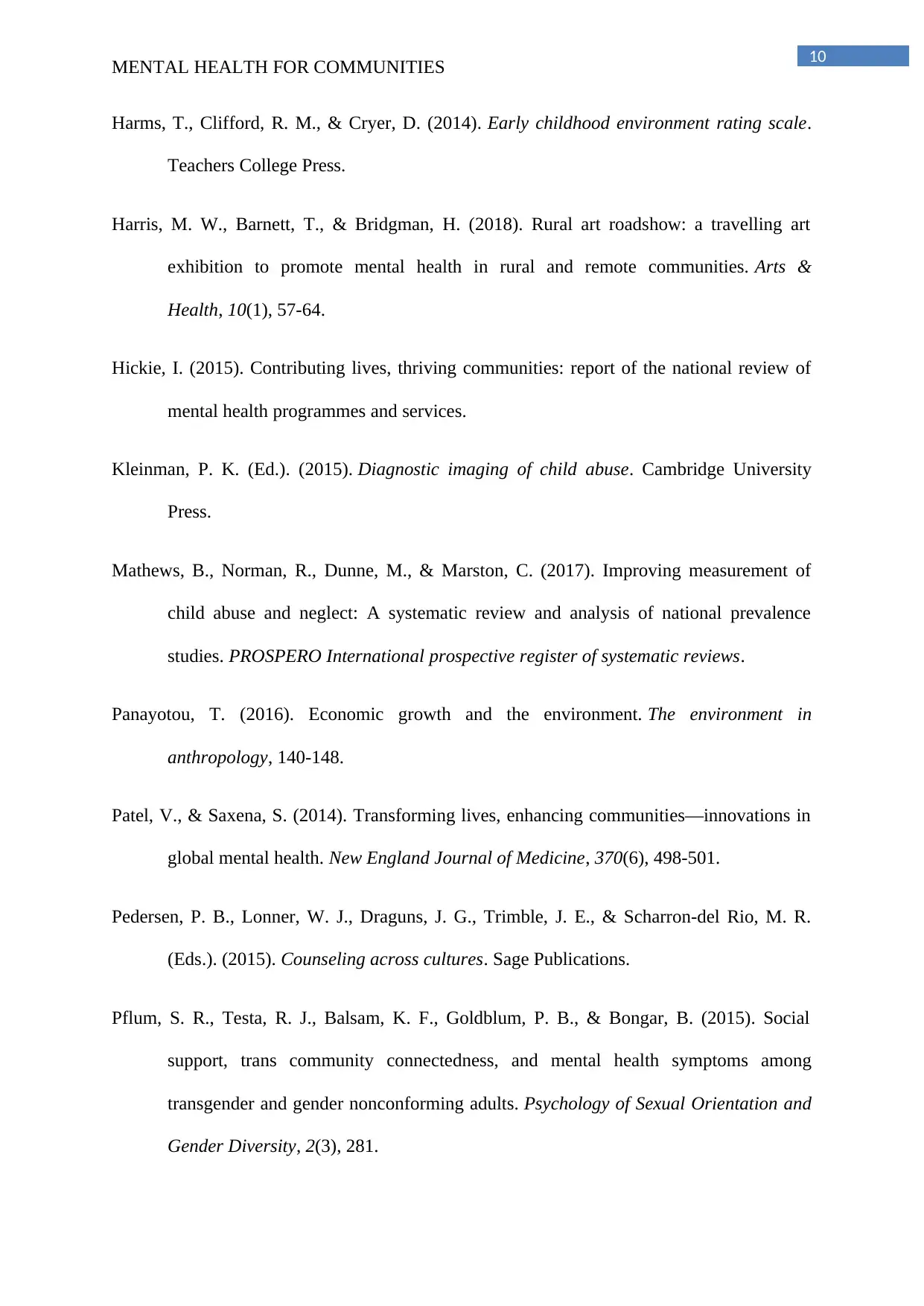
10
MENTAL HEALTH FOR COMMUNITIES
Harms, T., Clifford, R. M., & Cryer, D. (2014). Early childhood environment rating scale.
Teachers College Press.
Harris, M. W., Barnett, T., & Bridgman, H. (2018). Rural art roadshow: a travelling art
exhibition to promote mental health in rural and remote communities. Arts &
Health, 10(1), 57-64.
Hickie, I. (2015). Contributing lives, thriving communities: report of the national review of
mental health programmes and services.
Kleinman, P. K. (Ed.). (2015). Diagnostic imaging of child abuse. Cambridge University
Press.
Mathews, B., Norman, R., Dunne, M., & Marston, C. (2017). Improving measurement of
child abuse and neglect: A systematic review and analysis of national prevalence
studies. PROSPERO International prospective register of systematic reviews.
Panayotou, T. (2016). Economic growth and the environment. The environment in
anthropology, 140-148.
Patel, V., & Saxena, S. (2014). Transforming lives, enhancing communities—innovations in
global mental health. New England Journal of Medicine, 370(6), 498-501.
Pedersen, P. B., Lonner, W. J., Draguns, J. G., Trimble, J. E., & Scharron-del Rio, M. R.
(Eds.). (2015). Counseling across cultures. Sage Publications.
Pflum, S. R., Testa, R. J., Balsam, K. F., Goldblum, P. B., & Bongar, B. (2015). Social
support, trans community connectedness, and mental health symptoms among
transgender and gender nonconforming adults. Psychology of Sexual Orientation and
Gender Diversity, 2(3), 281.
MENTAL HEALTH FOR COMMUNITIES
Harms, T., Clifford, R. M., & Cryer, D. (2014). Early childhood environment rating scale.
Teachers College Press.
Harris, M. W., Barnett, T., & Bridgman, H. (2018). Rural art roadshow: a travelling art
exhibition to promote mental health in rural and remote communities. Arts &
Health, 10(1), 57-64.
Hickie, I. (2015). Contributing lives, thriving communities: report of the national review of
mental health programmes and services.
Kleinman, P. K. (Ed.). (2015). Diagnostic imaging of child abuse. Cambridge University
Press.
Mathews, B., Norman, R., Dunne, M., & Marston, C. (2017). Improving measurement of
child abuse and neglect: A systematic review and analysis of national prevalence
studies. PROSPERO International prospective register of systematic reviews.
Panayotou, T. (2016). Economic growth and the environment. The environment in
anthropology, 140-148.
Patel, V., & Saxena, S. (2014). Transforming lives, enhancing communities—innovations in
global mental health. New England Journal of Medicine, 370(6), 498-501.
Pedersen, P. B., Lonner, W. J., Draguns, J. G., Trimble, J. E., & Scharron-del Rio, M. R.
(Eds.). (2015). Counseling across cultures. Sage Publications.
Pflum, S. R., Testa, R. J., Balsam, K. F., Goldblum, P. B., & Bongar, B. (2015). Social
support, trans community connectedness, and mental health symptoms among
transgender and gender nonconforming adults. Psychology of Sexual Orientation and
Gender Diversity, 2(3), 281.
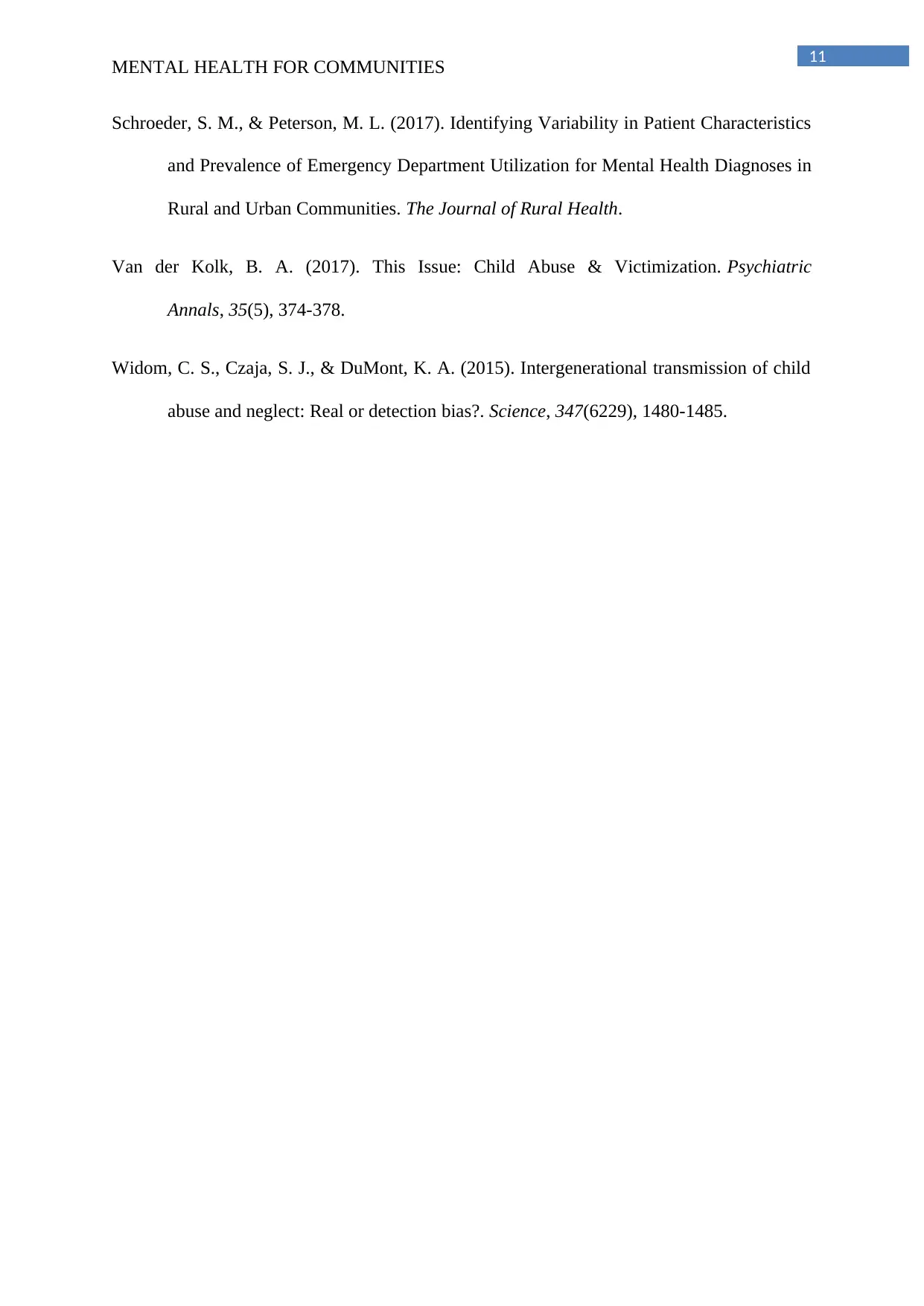
11
MENTAL HEALTH FOR COMMUNITIES
Schroeder, S. M., & Peterson, M. L. (2017). Identifying Variability in Patient Characteristics
and Prevalence of Emergency Department Utilization for Mental Health Diagnoses in
Rural and Urban Communities. The Journal of Rural Health.
Van der Kolk, B. A. (2017). This Issue: Child Abuse & Victimization. Psychiatric
Annals, 35(5), 374-378.
Widom, C. S., Czaja, S. J., & DuMont, K. A. (2015). Intergenerational transmission of child
abuse and neglect: Real or detection bias?. Science, 347(6229), 1480-1485.
MENTAL HEALTH FOR COMMUNITIES
Schroeder, S. M., & Peterson, M. L. (2017). Identifying Variability in Patient Characteristics
and Prevalence of Emergency Department Utilization for Mental Health Diagnoses in
Rural and Urban Communities. The Journal of Rural Health.
Van der Kolk, B. A. (2017). This Issue: Child Abuse & Victimization. Psychiatric
Annals, 35(5), 374-378.
Widom, C. S., Czaja, S. J., & DuMont, K. A. (2015). Intergenerational transmission of child
abuse and neglect: Real or detection bias?. Science, 347(6229), 1480-1485.
⊘ This is a preview!⊘
Do you want full access?
Subscribe today to unlock all pages.

Trusted by 1+ million students worldwide
1 out of 12
Related Documents
Your All-in-One AI-Powered Toolkit for Academic Success.
+13062052269
info@desklib.com
Available 24*7 on WhatsApp / Email
![[object Object]](/_next/static/media/star-bottom.7253800d.svg)
Unlock your academic potential
Copyright © 2020–2025 A2Z Services. All Rights Reserved. Developed and managed by ZUCOL.





